
by Francis Scott Fitzgerald






Lesson Plans
- Color Symbolism
- COMING SOON: Character Metaphors
- COMING SOON: Writing with Life Experiences
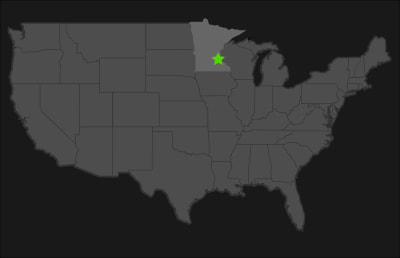
The novel introduces Nick Carraway, whose family has lived in Minnesota for 3 generations.
In 1915, at the age of 22, Nick graduates from his father’s alma mater, Yale, then leaves to fight overseas in World War I. He returns in 1918, at the age of 25 years.
Some time after, Nick begins wanting to move further east and join his friends, who are working as bond brokers in New York City’s Financial District.
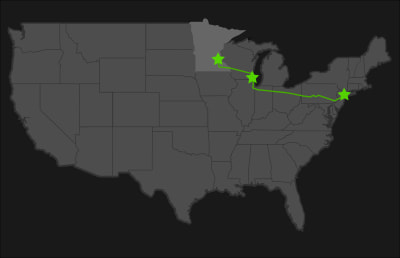
Nick moves to New York City from Saint Paul three years later, at the age of 29. He makes a brief stop in Chicago while on the way.
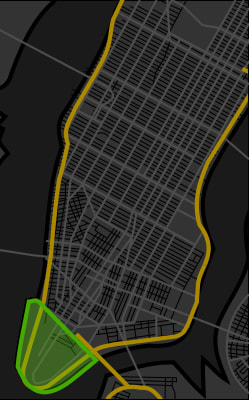
In New York City, Nick buys a set of golden books on banking and finance and begins working at a fictional brokerage firm called Probity Trust, located in the Financial District of lower Manhattan - which is described as a "white chasm" in later chapters.
While working there, he briefly dates a young woman who commutes from Jersey City, though the relationship ends after just a few weeks.
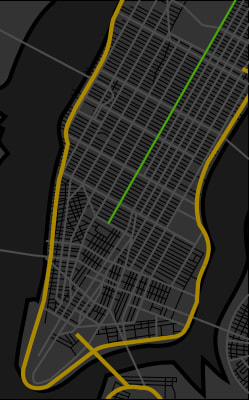
Nick describes regularly walking up 5th Avenue and admiring the beautiful women of the city while he travels around after work.
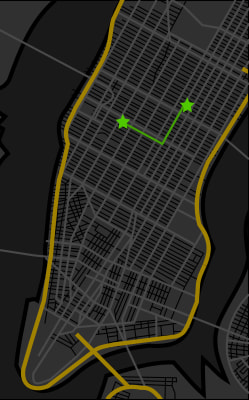
At night, Nick eats his dinners at the Yale Club, then uses the club's library to study for one hour before ending his work days.
To go home, he walks down Madison Avenue, past the old Murray Hill Hotel, turns on 33rd Street, and commutes through Pennsylvania Station.
(Long Island, NY)
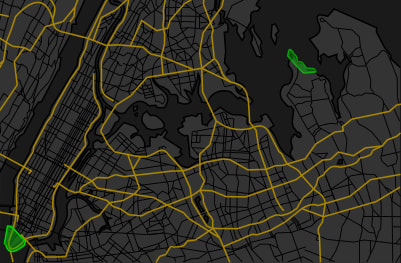
Not long after arriving in New York, a coworker invites Nick to room together in a commuter town 20 miles east of the city, called West Egg.
West Egg is a fictional town situated at the real-life location of King’s Point in Great Neck, Long Island. In the novel, it’s described as the preferred neighborhood for those with “New Money” - or newly acquired wealth. The homes and residents here are more eccentric than classic or formal.
After Nick agrees to move to West Egg, his roommate's job reassigns him to Washington, leaving Nick to move in alone. He brings with him an old Dodge automobile and a pet dog that soon runs away. He also hires a Finnish maid who regularly comes to tidy his room and cook his breakfast, which is an early sign that despite Nick seeing himself as embarking on a self-made path, he hasn’t fully left behind the financial comfort of his upbringing.
Nick’s rental home is described as being at the tip of West Egg, just 50 yards from the Long Island Sound, with a direct view of the water. It includes a shed where he parks his car, and sits between two enormous homes.
The house to the right is Gatsby’s home.
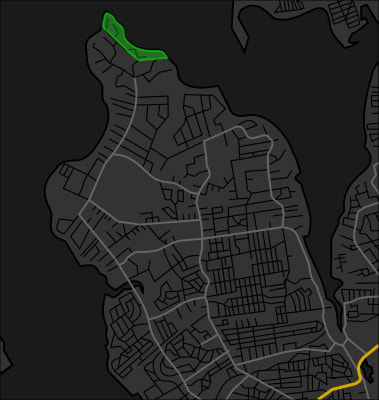
Gatsby's home is styled after the Hotel de Ville in Normandy, France.
It includes a single tower, raw ivy climbing up the walls, a marble swimming pool, a private beach with a floating diving tower, a pebbled driveway, Marie Antoinette–style music rooms, imported and restored salons and period bedrooms, multiple dressing rooms, various game rooms, a fully stocked bar, and forty acres of lawn and gardens featuring jonquils, hawthorns, plum blossoms, a white plum tree, and midsummer flowers.
Every weekend, Gatsby’s home hosts extravagant public parties, featuring yellow cocktail music and foods that appear almost golden. His Rolls-Royce transports guests to and from the city from nine in the morning until well after midnight. His yellow station wagon also shuttles people to and from the local train station in Great Neck, Long Island.
Long Island, NY
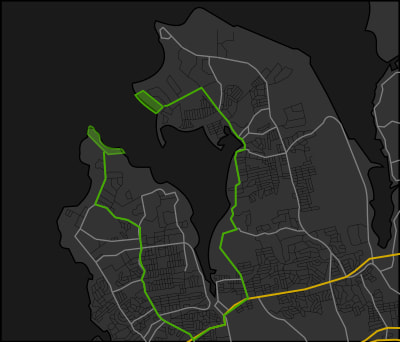
After settling into his new home, Nick drives to East Egg to visit his second cousin, Daisy, and her husband, Tom Buchanan. Tom is a former Yale football star who belonged to the same senior society as Nick.
Tom and Daisy live just across the bay from Nick, in East Egg – which is on the real-life location of Sands Point, Long Island. East Egg is described as the preferred neighborhood for those associated with “Old Money,” or wealth that has been inherited across generations. East Egg has a more classic and regal style of architecture, and is filled with white homes.
The Buchanan home is a red and white Georgian Colonial mansion, with vines growing on the sides, gold-framed French windows, a front porch, connecting verandas, and a lawn that stretches a quarter mile from the beach to the door. The grounds are filled with sun-dials, brick walkways, and well-tended gardens. There is also a dock that goes into the water from the beach, with a green light that flashes all day and night.
While visiting the Buchanan home, Nick learns about Tom’s poorly hidden affair with another woman, is told about their three-year-old daughter, and meets Jordan Baker. Jordan is Daisy's childhood friend, and she is currently staying at the house. Both Daisy and Jordan are wearing white dresses on this summer evening.
As Nick reflects on Tom and Daisy’s past, Tom begins to voice blatantly racist views, revealing that he aggressively sees himself as inherently superior to others. His comments reflect his own insecurities about the growing influence of people outside the “Old Money” class and the white race. He worries that the privileges once guaranteed to his social group are no longer assured. As the scene continues, it underscores the hypocrisy of “Old Money,” which maintains the veneer of poise, taste, and manners, but often conceals deep hatred and corruption.
After 10pm, Jordan retires for the night. Daisy then asks Nick about a woman he is romantically involved with back in Missouri before he returns to his home in West Egg.
(Queens, NY)
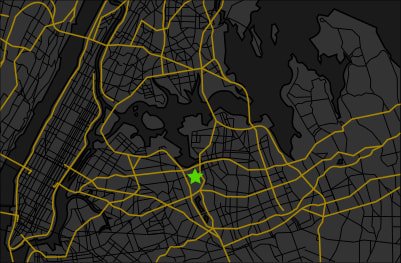
Between Nick’s home and New York City lies an area known as the Valley of Ashes. At this time, it was as a dumping ground for garbage and ashes from the city. Today, the real-life location is Flushing Meadows Corona Park in Queens, New York.
The area is described as being filled with ridges, hills, chimneys, smoke, and a large billboard advertising an optometrist’s practice nearby. A river runs through the area, with a drawbridge that delays trains and traffic when it is raised. A single yellow-brick building sits on the edge of the remains of what was once a small town. The building houses three shops, one of which is a garage with a faded sign that says, “Repairs. GEORGE B. WILSON. Cars Bought and Sold.”
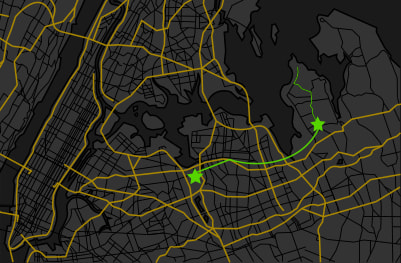
One Sunday afternoon, just before the Fourth of July, Tom and Nick take a train into the city. Though they disembark while the drawbridge is raised.
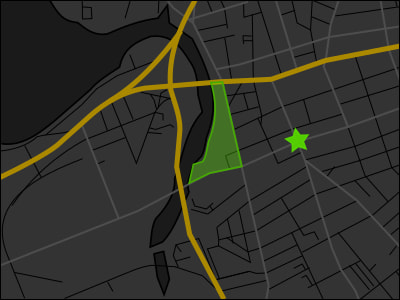
Tom and Nick hop over a low, white-washed railroad fence and walk a hundred yards along the main street towards the garage in the yellow brick building.
There, Nick meets the woman Tom is having an affair with, Myrtle, and her husband, George.
While Myrtle’s husband steps into another room after discussing working on Tom’s car, Tom quietly tells Myrtle to take the next train and meet them in the city.
Tom and Nick then leave to wait by the drawbridge for the next train.
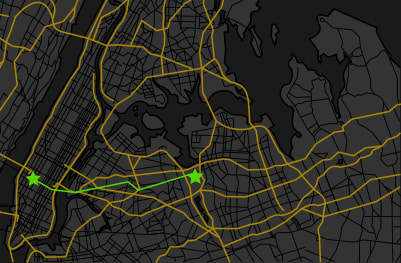
Nick, Tom, and Myrtle take the next delayed train into the city.
At Pennsylvania Station, Myrtle begins to indulge in various luxuries by asking Tom to buy her cold cream and perfume from the station’s drugstore, along with a magazine from a newsstand. They then head out to the street and wait for a taxi, though Myrtle insists on waiting for a newer model that is specifically painted lavender with a grey interior.
Before driving off, she also asks Tom to buy her a dog with “surprisingly white feet” from a man selling puppies nearby.
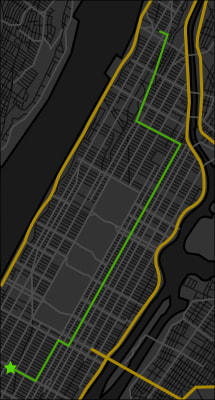
The taxi drives to 5th Avenue, then veers to Park Avenue before heading north to the Upper West Side.
At 158th Street, it stops in front of a row of white apartment buildings. Inside, an elevator boy takes Nick, Tom, and Myrtle to a top-floor apartment.
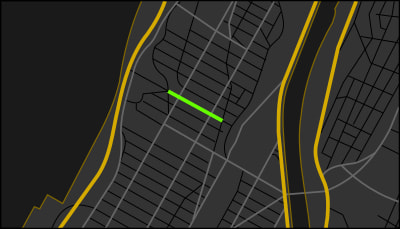
Nick begins to drink in the apartment at 8pm. Other people whom Myrtle had invited also begin to arrive. During the evening, Myrtle tells Nick how she first met Tom on a train, and how she was drawn to him as he stood in the aisle while wearing a crisp, white shirt. Not long after arriving, Nick steps out to a corner store to buy cigarettes.
After returning to the apartment, Tom becomes drunkenly enraged with Myrtle as she mentions Daisy's name, and he brutally hits her.
Though Tom prides himself on his family and manners, he is cruel to those who are not associated with "Old Money". This scene further reveals his hypocrisy. Far from being a loyal husband or a true gentleman, he is aggressive, entitled, and emotionally unfaithful.
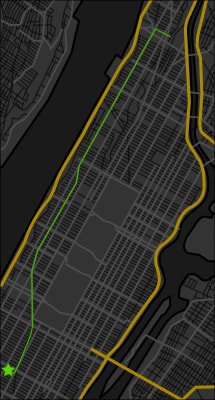
In the early morning, Nick leaves with a neighbor from the apartment just below. He then exits the building alone and walks south along Broadway while the city is quiet. He reflects on false appearances and how they differ from reality, and feels a sense of moral decay that is constantly lingering.
Eventually, he arrives at Pennsylvania Station and waits for the 4am train to go back to Long Island.

One summer day, Nick receives a formal invitation to attend one of Gatsby’s parties. On the night of the event, Nick crosses the lawn in white clothing, and attempts to find Gatsby but ultimately fails.
After becoming embarrassed for coming to a party alone, Nick runs into Jordan Baker, who wraps her "golden arm" around his and welcomes Nick into her group. After Jordan speaks with two girls in yellow dresses who are fans of her, she then abandons her date to join Nick in searching for Gatsby.
Inside the home’s library, they encounter a random party guest who is admiring the room's books. Shortly after, Nick is finally introduced to Jay Gatsby himself.
During their short introduction, Gatsby invites Nick to meet again the following morning, then leaves to speak with Jordan privately for one hour.
At 2am, Jordan emerges from her conversation with Gatsby and says goodbye to Nick, without sharing what they had discussed. Nick then bids farewell to Gatsby and crosses the lawn to return home.
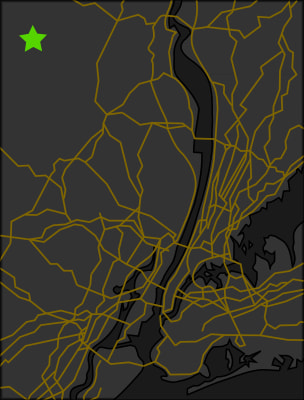
Nick loses contact with Jordan for several weeks, but now visits Gatsby’s home regularly. However, he and Jordan reconnect mid-summer at a house party in Warwick.
Nick and Jordan leave the party together, however Nick decides to hold back from flirting with Jordan further until he ends his relationship with the girl he had left behind in Missouri, whom he still writes to romantically. This reveals that Nick is not as honest as he believes himself to be.
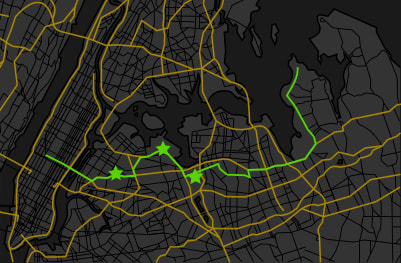
One morning, Gatsby drives Nick into the city to have lunch together. Gatsby's car is described as being yellow with a green leather interior.
One morning, Gatsby drives Nick into the city for lunch in his distinctive yellow car with green leather interior.
During the ride, Gatsby begins to tell Nick a glamorized version of his past. At first, Nick is reluctant to believe Gatsby's stories, but then wonders if everything is true after being shown with a rare medal that Gatsby received for fighting in World War I.
Gatsby wants to show Nick that has he become successful through his own efforts, and Nick questions whether Gatsby truly is a self-made man who gained wealth and success after becoming a war hero.
As they drive, they pass by a seaside port, cobbled slums, abandoned saloons dating back to the early 1900s, the Valley of Ashes, and Mr. Wilson’s gas station. However the drive is interrupted halfway through Astoria when they are pulled over by a police officer for speeding.
Gatsby shows his business card after stopping, which causes the officer to refrain from giving a speeding ticket. As this happens, it is clear that Gatsby sees himself as being above the laws that others follow.
After the encounter, Gatsby continues over the Queensboro bridge and crosses Blackwell’s Island - which is called "Roosevelt Island" today - then finally enters Manhattan.
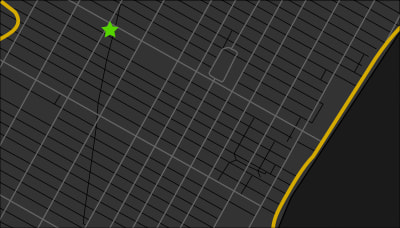
At noon, Gatsby and Nick arrive at a well-ventilated cellar on 42nd Street, located across from the Hotel Metropole, which has been demolished and replaced by the Times Square Tower today.
Over lunch, Nick meets Gatsby's business partner, Meyer Wolfsheim, and learns of his organized crimes, such as rigging the 1919 World Series.
Wolfsheim shows the darker side of Gatsby’s wealth, and hints of illicit means behind Gatsby's fortune, as well as the dangerous social circles around him.
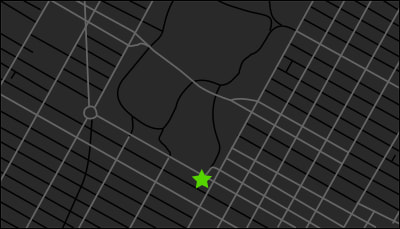
In the afternoon, Nick parts ways with Gatsby and meets with Jordan at the Plaza Hotel’s tea garden. There, Jordan reveals that Daisy and Gatsby once shared a romantic relationship five years earlier while in Louisville, Kentucky, which is Daisy and Jordan’s hometown.
Jordan also reveals that Gatsby has confided in her about still being in love with Daisy.
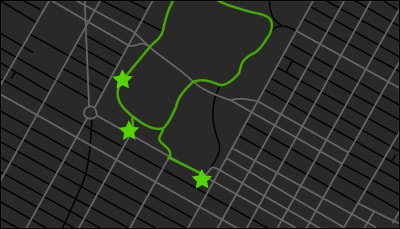
After leaving the Plaza Hotel, Nick and Jordan spend about 30 minutes driving through Central Park in an old Victoria carriage as the sun sets.
Near the end of their ride, Nick finally kisses Jordan.

Nick returns to Long Island after his day in the city with Gatsby and Jordan.
At home, Gatsby intercepts Nick as he arrives, and invites Nick to Coney Island while offering him a job. Nick politely declines both offers, but agrees to something far more important to Gatsby - inviting Daisy over for tea in two days, giving Gatsby the chance to finally reunite with her.
This scene is also significant because it highlights Gatsby’s “New Money” mindset: rather than expressing simple gratitude, he tries to repay Nick’s kindness with offers and favors, treating friendship as transactional rather than a bond.

It is a sporadically rainy day when Daisy comes for tea.
At 11am, Nick’s grass is cut by gardeners hired by Gatsby, while Nick goes into town to buy cups, lemons, and flowers.
By 2 pm, an overwhelming variety of flowers arrives at Nick’s home, also arranged at Gatsby’s request.
At 3pm, Gatsby anxiously arrives at Nick's home. He is wearing a white suit with a gold tie, and acts restless while waiting for Daisy to come.
At 4pm, Daisy arrives and tells her driver to return in an hour.
As she steps inside Nick’s home, she is stunned to see Gatsby standing there. Then, after 30 uncomfortable minutes, Nick leaves the two alone for half an hour by exiting through the back door. The rain subsides during this time, though the wind and distant thunder remain.

When Nick returns, he finds that Gatsby and Daisy have clearly reconnected. Daisy wipes away tears as Nick steps inside, suggesting that she has confided in Gatsby during their time alone. The emotional tension lingers, but the atmosphere lightens as the three decide to visit Gatsby’s mansion.
As they explore Gatsby's home. Daisy gives extra admiration to the golden items around her. Gatsby also points out the green light that constantly shines at the end of her dock from across the bay.
These colors, gold and green, are threaded throughout the novel as symbols of Daisy’s connection to "Old Money" and enormous wealth.
During the tour, Daisy breaks down and begins to cry in Gatsby's room while looking through his collection of luxurious shirts. This can either be due to her seeing that Gatsby could have given her the life she had wanted, or perhaps the deeper, more unsettling truth is that she realizes that it is not the men around her that she falls in love with. Instead, she only loves the wealth that someone reflects.
After Daisy leaves, Gatsby opens up to Nick. He shares more information about of his past, revealing the extent of the transformation he underwent to pursue success. It is then evident to Nick that Gatsby has achieved the "American Dream" by becoming rich, however to achieve the dream, Gatsby had to reinvent himself, leave his home, and continually reshape his identity to match the expectations of the elite around him.
Yet through it all, Nick describes Gatsby's grand gestures and accumulated wealth as all stemming from one pure motivation: his love for Daisy.

One Sunday afternoon, while Nick visits Gatsby's mansion, Tom arrives with a man and an attractive woman.
Gatsby appears and welcomes the visitors, though Tom becomes surprised and curious after learning that Gatsby is acquainted with his spouse, Daisy.
As the conversation continues between Gatsby and the three visitors, Gatsby invites the group to return the following weekend for a party, which they accept. However, Gatsby also invites the group to dinner, which the group collectively rejects.
In true “Old Money” fashion, the group gives with a superficial display of courtesy by inviting Gatsby to dine with them instead, which is a gesture that they expect Gatsby to decline out of social awareness. Gatsby, however, excitedly accepts their offer - unaware of the customs of "Old Money", which expect Gatsby to reject the offer since they had rejected his.
Astonished and literally appalled by Gatsby's acceptance of their hollow invitation, Nick watches the group rush to leave before Gatsby can return to join them. This moment further shows the false veneer of “Old Money” politeness - which is often nothing more than a superficial civility used to mask exclusion, and also highlights that Gatsby may strive to emulate being of "Old Money," but his “New Money” origins are impossible to hide.

Tom arrives at Gatsby's party with Daisy the following Saturday.
Daisy recognizes some of the faces of the famous celebrities around her, though neither Tom nor Daisy know anyone by name, since they are not part of the "Old Money" community. While mingling, Daisy also shares with Nick that she gives out green cards to those she meets while introducing herself.
Tom soon drifts off to mingle with others, leaving Daisy and Gatsby to dance together and spend half an hour alone on Nick’s porch, while Nick stands guard in Gatsby’s garden to ensure their privacy.
Nick, Daisy, and Gatsby later reunite with Tom for dinner, though Tom says he will dine with another group instead. Daisy then gives Tom a golden pencil to use for writing down addresses he would like to keep, showing Tom that she does not care about his flirtations with others. She also refers to the lady Tom is speaking with as "common but pretty".
As everyone dines, Nick notices Daisy becoming visibly appalled by the untamed demeaner of the "New Money" guests around her.
Eventually, Daisy and Tom leave to drive home, though it is clear that Daisy enjoyed neither the location, West Egg, nor the people who had attended the party, in comparison to the "Old Money" community she is accustomed to at East Egg.
Nick remains behind and speaks with Gatsby.
Gatsby insists that Daisy never truly loved Tom, and that she will leave her marriage to return to Louisville, Kentucky with him - which is where they met. There, they will then marry and recreate the past as though the five years apart had never passed. Gatsby also reflects on his memories about when he met Daisy, including how she was wearing white clothing and drove a white car.
Nick warns Gatsby that his dream may be unrealistic, but Gatsby refuses to believe that Daisy has changed, moved on, or made a new life for herself since they last saw one another five years ago.
Nick is partially appalled by Gatsby's intentions. He sees that Gatsby has turned Daisy into an idealized symbol of perfection in which he has sacrificed his entire identity for.

Gatsby’s home suddenly falls quiet for weeks, and no more lavish parties occur.
Concerned, Nick eventually walks over to see if Gatsby is ill, but the butler turns him away without offering a reason.
Later that day, Gatsby calls Nick’s home and explains what has happened. Daisy has begun visiting regularly. To hide their affair, Gatsby dismissed his entire household's staff, and replaced them with men connected to Wolfsheim instead, who could be trusted to keep quiet.
Gatsby then asks Nick to come to Daisy’s house the following afternoon, and Daisy also calls with the same invitation 30 minutes later.
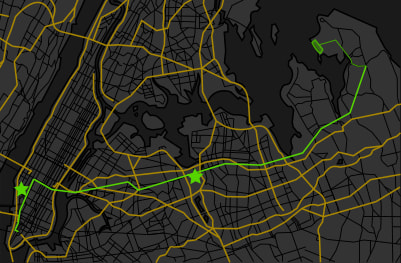
On a stiflingly hot afternoon, Nick leaves from work and boards the noon train to go to Daisy’s home, passing by the National Biscuit Company while on the way - which is now known as Nabisco.
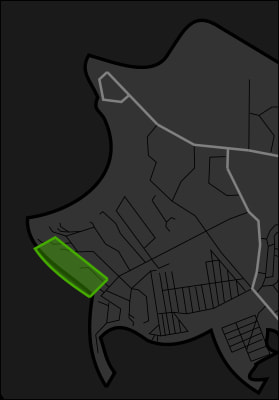
At the Buchanan home, Daisy casually asks Tom to make everyone cold drinks.
When Tom leaves the room, Daisy brazenly kisses Gatsby in front of both Nick and Jordan, causing Jordan to complain about the action and call Daisy vulgar, showing her discomfort with Daisy's disregard for discretion.
The Buchanan’s child, Pammy, then enters the room with her nanny, showing off her white dress to Daisy. Daisy reveals that she specifically asked Pammy to wear the dress for meeting Gatsby, and tries to introduce the child to the group. However, Pammy instead asks where her father is: Tom. As this happens, Gatsby also looks at the child in shock, finally seeing evidence that Daisy had, indeed, created a life away from him. Soon, the child returns to the nanny and they both leave when Tom returns with their drinks.
Tom then tours Gatsby around the home's verandas before everyone sits to eat in a dimly lit dining room. There, Daisy suggests going into the city to lighten the mood among the group.
Over the table, Tom realizes that Daisy and Gatsby are having an affair when she glamorizes Gatsby and compares him to an advertisement. The reference strikes Tom with clarity, since he knows that her attraction falls on appearances, by wealth, and shine. This comparison reveals that Gatsby has become her new obsession.
With a new sense of control, Tom insists they drive into the city. The suggestion is no longer casual, and he is ready for a confrontation elsewhere.
While preparing to leave, Gatsby tells Nick that Daisy's voice, "is full of money," causing Nick to realize that her voice truly does sound bright and metallic, like spare change clinging against other coins. This comment also shows that Gatsby partly sees marrying Daisy as proving his wealth and status within the world of "Old Money".
Everyone leaves for New York City, but in two separate cars. Tom insists on driving Gatsby’s beige car, and Gatsby drives Tom’s blue car - to ensure that Daisy and Gatsby do not simply run away together, which Tom now fears.
On the way into the city, Tom stops for gas at George Wilson’s garage in the Valley of Ashes. There, he learns that George has grown suspicious of Myrtle’s infidelity, though he doesn’t yet know who she is having an affair with. After George announces his intention to move away from Long Island with Myrtle, Tom continues through Astoria and crosses the Queensboro bridge into the city, trying to catch up to Daisy and Gatsby's car.
During this time, Nick reflects on how Tom is no different than George, except for one thing: wealth. Both Tom and George are in parallel situations, yet George has become sickly from his work and lack of ability to seek healthcare, while Tom is strong and healthy due to his wealth and status.
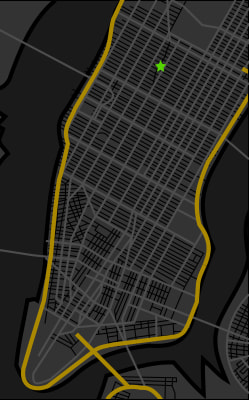
After regrouping in the city, the group briefly considers seeing a movie around Fiftieth Street to escape the heat. But when Daisy dismisses the idea and casually suggests they split up, Tom abruptly insists that they all go to the Plaza Hotel instead.

At 4 PM, the two cars travel to the south side of Central Park to arrive at the Plaza Hotel, where they books a parlor suite. Daisy first suggests booking five bathrooms for individual cold baths, but then settles on booking one room and making mint juleps for everyone - even though she does not drink alcohol, and neither does Gatsby.
Once in the room, a confrontation erupts as Tom questions Gatsby's class and status. Tom begins to unravel Gatsby’s carefully constructed image, attacks his vague backstory, and accuses him of being involved in criminal activities, including bootlegging, rigged gambling, and a more sinister scheme that is not described in detail.
During the conversation, Gatsby’s dream begins to crack. He’s stunned when Daisy states that she truly had fallen in love with her husband, Tom, and that her life was not shaped and dictated by the single month of romance that they had shared together in Louisville - which had become so central to Gatsby's life.
The conversation ends when Gatsby is pushed to his emotional limit. He erupts and lunges to attack Tom, only just managing to restrain himself. In that moment, the intensity of his rage is so raw and agressive that he appears as though he had killed others before. No differeent than Tom, Gatsby is not as gentlemanly as he portrays himself as being.
Daisy is visibly shaken from this moment, and whatever illusions she held about Gatsby and his elegance and status before shatter instantly. Gatsby is not the self-made, wealthy man that she thought he was, but is a dangerously volatile gangster instead.
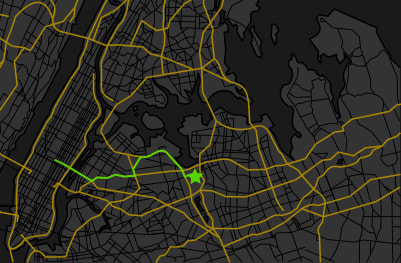
At 7 PM, the group begins the tense drive back to Long Island.
Gatsby and Daisy depart together in Gatsby’s yellow car, while Tom drives his own vehicle with Nick and Jordan. Tom is no longer worried about Daisy running away with Gatsby. In his mind, the matter has been settled.
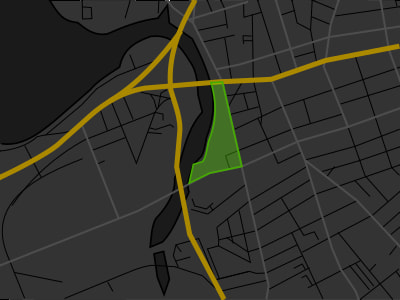
On the way back to East Egg, Tom stops at Wilson’s garage in the Valley of Ashes after noticing a growing crowd. Inside, he learns that Myrtle has been struck and killed by Gatsby’s car, which then fled from the scene without stopping.
A witness then incorrectly describes Gatsby's car to the police as being "light green", and Myrtle's body also lies openly under a yellow light as people discuss what happened.

After arriving at the Buchanan home at 9:30pm, Tom calls for a taxi to take Nick home after Nick refuses to come inside. Disgusted by the evening’s events and the people involved, Nick brusquely declines Jordan’s invitation as well, showing the growing rift between him and those within the social class that he has been born into.
As Nick walks towards the gate to wait for the taxi away from others, he notices Gatsby hiding in the bushes.
Nick learns from Gatsby that Daisy was driving the car when Myrtle was killed, and Gatsby is now waiting for Daisy to flicker the lights from inside her home, to signal if she is in trouble with Tom.
Daisy is now hiding who she is through Gatsby's protection, just as Tom hides who he truly is behind fake manners. It is also clear that Gatsby has little care for Myrtle's death, and only cares about winning Daisy's heart.
Nick tries to tell Gatsby that his worries about Tom hurting Daisy are unfounded, though Gatsby refuses to believe him.
In an effort to allay Gatsby’s worries, Nick goes around the home and peers through a window to see if anything is amiss. Inside, he sees Daisy and Tom seated together, talking quietly instead. Although Nick cannot hear their words, it is clear that they are not fighting, but are actually scheming together. Nonetheless, Daisy is in no distress.

Nick has a restless night and spends it listening to the fog horn from the Long Island Sound.
When he finally hears a taxi arrive in Gatsby’s driveway, he gets out of bed, crosses the lawn, and enters through Gatsby's front door, which has been left open.

Nick has a restless night listening to the fog horn in the Long Island Sound.
When he hears a taxi arrive at Gatsby’s driveway, he gets out from bed, crosses the lawn, and enters through Gatsby's front door, which was left open.

Gatsby tells Nick that he left Daisy’s house at 4 AM, after she came and stood at a window, and then turned off the light without giving any signal.
Nick and Gatsby now move into the drawing room, open a few windows, and begin to smoke together. Nick urges Gatsby to leave for Atlantic City or Montreal to avoid the consequences of the previous night’s tragedy. But Gatsby refuses. Instead, he is adamant that he will not give up on his dream of being with Daisy - even though it’s clear that his dream will never come true.
As day breaks, they open the rest of the windows and eat breakfast together on the porch. Gatsby then invites Nick to swim in the pool before it is drained for the fall, however Nick declines and says he must leave for the next train to go to work.
Before leaving, Nick offers Gatsby a rare compliment. One that, he notes, was the only one he ever gave him.
Until now, Nick has disapproved of Gatsby's life to a certain extent. Although now, Nick clearly prefers Gatsby's dream to those of the "rotten crowd" that surrounds them both. Gatsby simply wants to be with Daisy.
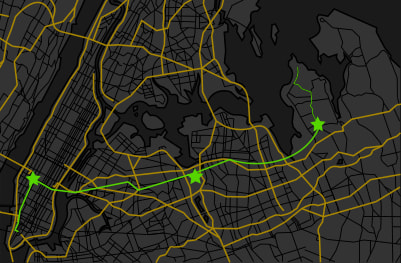
Nick has a bad feeling and does not want to leave for work. Though, he does a little after 9am, and reflects on the fact that he first entered Gatsby’s home exactly three months earlier.
Nick purposefully misses two trains before finally taking the third into the city, though he falls asleep in his work chair not long after arriving.
He wakes when Jordan calls his office at noon, explaining that she moved out from the Buchanan home and is now living in Hempstead - though she’s preparing to leave for Southampton soon.

Nick calls Gatsby’s home after hanging up with Jordan, but the line is busy. He tries four times; finally learning that the line is being kept open for a specific call.
Nick feels anxious about Gatsby, and looks at the train schedule to circle the next train he can make, which is at 3:50 PM.

Nick boards the 3:50pm train back to Long Island, deliberately choosing a seat on the side that is opposite of the garage where Myrtle was killed the night before. Nick wants to avoid looking at the crime scene.

A flashback now occurs, showing what events took place with George and Myrtle at the garage since the day before.

At 2pm, Gatsby puts on his bathing suit to go for a swim under the yellowing trees.
He walks to his garage with his chauffeur and inflates a pool float. He then goes to the pool and tells the chauffeur to not remove the now-damaged car from the garage.
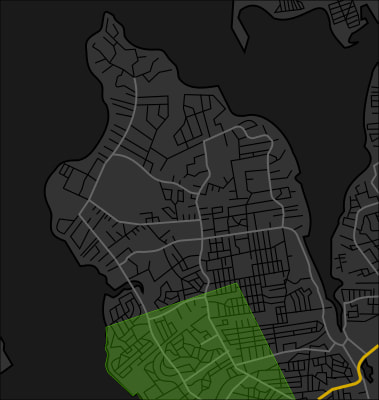
At 2:30 PM, George has walked all the way to Mr. Gatsby's area from Queens, and begins inquiring people about where Gatsby lives.
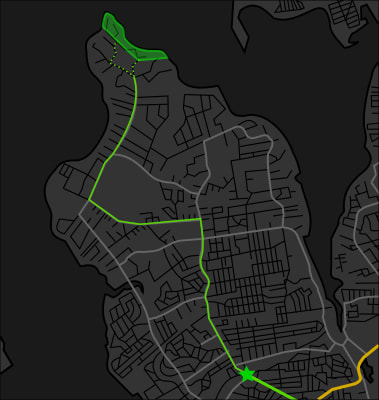
After 4pm, Nick disembarks from the train and drives to Gatsby's home.

In the afternoon, the chauffeur hears multiple shots fired as George arrives and murders Gatsby by the marble swimming pool before turning the gun on himself as well. Nick arrives just after.
Nick, the chauffeur, the butler, and the gardener rush to the back of the home to find Gatsby’s body in the pool.
While working to move the body inside, they notice George's body on the lawn as well.

Nick calls Daisy after bringing the body inside. However he is told by the butler that everyone had already left the Buchanan home with their luggage fully packed.
Nick also tries to contact Wolfshiem, to notify him of Gatsby’s funeral. However Wolfsheim responds that he will not attend.
For two days, the property is filled with police, journalists, and teenagers that sneak onto the grounds to observe the crime scene at the pool. No one person inquires about Gatsby personally or intimately. Nick now begins to resent everyone who once came to the parties.
On the third day, a telegram signed by Henry C. Gatz arrives from Minnesota, asking for the funeral to be postponed until their arrival. The man is Gatsby’s father.
Henry Gatz arrives soon after, saying that he saw the news of his son's passing in a Chicago newspaper. He asks to see his son - "Jimmy" - who is laid in the drawing room. Ironically and sadly, the person who cared about Gatsby most, his father, was left behind as Gatsby reinvented himself, left the Midwest, and chased after his dreams of obtaining wealth and marrying Daisy.
Gatsby's father, Gatz, spend the day admiring Gatsby's home and possessions, and tells Nick how proud he is of the life his son had created and the friends and connections he had made - even though Nick knows that Gatsby was actually alone, and was surrounded by people who did not care for him.
The funeral is scheduled for the next day at 3PM, and Gatz states that Gatsby would have wanted to be buried in New York where he had built his life, instead of being buried at home in the Midwest, which he ran away from.

After unsuccessfully going into the city to ask Wolfsheim to attend the funeral one final time, a minister arrives at Gatsby’s home on a rainy afternoon to begin the funeral procession.
Nick asks the minister to wait 30 minutes for other guests to arrive.
However, no one comes.
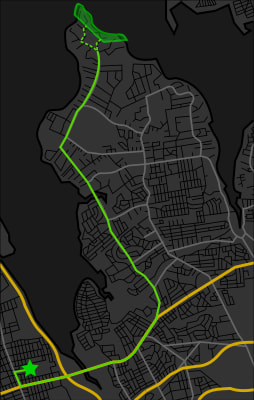
At 5pm, the funeral procession begins with Nick, Gatsby's father - Henry Gatz, and the four or five servants who remained.
The rain increases as they proceed.
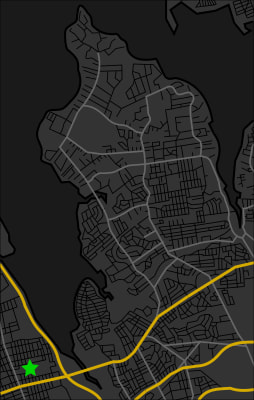
At the cemetery, the one party guest that Jordan and Nick had met weeks earlier (Chapter 3) arrives in his own car.
The visitor voices pity for Gatsby after quickly realizing that he is the only other person to attend the funeral procession. However, the visitor is clearly just attending as a spectator, and is only admiring the scene with itnerest just as he was admiring the books within the library before.

After the funeral, Nick is haunted by Long Island and decides to leave New York to return to Missouri.
Before leaving, he meets with Jordan to discuss the end of their relationship, and also happens to run into Tom on 5th Avenue on a separate day.
Nick confronts Tom after he is taken aback by Tom's surprisingly relaxed demeanor. During the confrontation, Nick learns that Tom had encouraged George to find and attack Gatsby, after convincing him that Myrtle and Gatsby were having an affair together. Tom believed his actions to encourage the attack were justified, leaving Nick furious with both Tom and Daisy.

Nick returns to Missouri by train and feels at home.
He passes by the yellow cars of Chicago, Union Station, Milwaukee, and heads to the Saint Paul by passing through small Wisconsin stations that are described as looking cheerful in the wintery environment.
While on the train, Nick reflects on the fact that he, Jordan, Daisy, Tom, and Gatsby were all Midwesterners, who likely did not fit in with society on the East Coast.

As the book ends, Nick reflects on his final night living at the rental home on Long Island.
His luggage was packed, his car was sold, and he went to Gatsby’s home one last time.
The grass was overgrown as he walked up to the front stairs, and he cleared away some graffiti that had been scratched into the steps. He then walked around to the now-vacant private beach, and could clearly imagine the sound of the music and voices from the parties that had just been regularly occurring every weekend during the summer.
He laid on the sand, looked across the bay, and saw the green light shining from what used to be Daisy’s dock. He reflected on what Gatsby’s reaction to it had once been, and how the green land it sits on also once sprung hope upon the Dutch who first arrived from Europe.